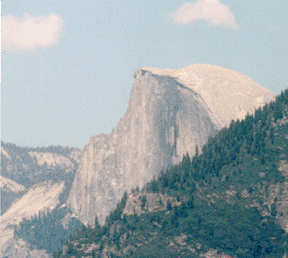CHAPTER 5: WEATHERING, EROSION, AND SOIL
WEATHERING--the disintegration and decomposition of rock at or
near surface.
MASS WASTING--the transfer of rock material downslope under the
influence of gravity.
EROSION--the incorporation and transportation of material by a
mobile agent:
WATER, WIND, or ICE.
Weathering falls into two catagories: MECHANICAL WEATHERING (physical weathering process)
and
CHEMICAL WEATHERING.
MECHANICAL WEATHERING - "making big pieces into smaller
pieces"
Types of Mechanical Weathering:
CHEMICAL WEATHERING--involves chemical transformation into 1
or more new materials.
- H2O + CO2 = H2CO3 (carbonic acid) from atmosphere and plant
acids dissolve most
rocks through time.
- H2CO3 + CaCO3 (calcite) = Ca+2 + HCO3-, a reversible
process (land and oceans).
Calcite is the primary mineral in limestone. Calcite also acts a
a cement in sediments to
form sedimentary rocks.
- Quartz (SiO2 ) dissolves and reprecipitates as silica, which
acts as a cement in sediments
to form sedimentary rocks.
- Feldspar weathers to become clay (reversible under
metamorphic conditions).
- Mafic Minerals become clay, silica, and iron oxide minerals
(limonite/hematite).
- Cations (such as K+, Na+, Ca++ and anions (such as Cl-,
HSO4- ,HCO3-) stay in
solution and add to the saltiness of the ocean, precipitate as
salts, or are incorporated into
clays in sediments.
WEATHERING FEATURES
Rock exposures, such as on cliffs or barren hilltops, have
characteristic appearances due to
Spheroidal Weathering (the "rounding of rough edges") that occurs because chemical attack
is more effective on corners (it comes from 3 sides of the corner) compared to faces (chemical attack is only from one direction) and
Differential Weathering (some rocks and rock layers resist erosion better than
others) creating a rough weathered surface. Hoodoos and arches are the result of
differential erosion and the beauty of these features has inspired us to create two
national parks Arches and Bryce Canyon National Parks, both in Utah.
As chemical and mechanical weathering proceed, rock material
accumulates as a
REGOLITH layer of rock and mineral fragments produced by
weathering. If water is
available, plant and animal activity affect the material, and
dead organic matter accumulates.
This results in the FORMATION OF SOIL.
SOIL--mineral matter (~45%), HUMUS--organic matter (~5%), air &
water (~50%).
CONTROLS OF SOIL FORMATION
- PARENT MATERIAL--the original mineral matter can be either:
RESIDUAL
(regolith that accumulates "in place") or TRANSPORTED mineral
material by water, wind,
or ice.
- TIME--important to all geologic processes; longer
exposure = more weathering.
- CLIMATE--water and temperature affect weathering processes.
Hot & humid climates
produce deep weathered soils lacking essential nutrients. Cold &
dry climates results in very
slow weathering which increases chances of wind erosion before
soil can form.
- PLANTS & ANIMALS: microscopic organisms do most of the work;
the acculation of
organic mater forms HUMUS; roots, worms, rodents, and insects
rework the regolith and
humus to form soil.
- SLOPE - soils tend to be thickest on flat surfaces (due to
mass wasting & erosion).
Sunny slopes tend to be warmer and dry faster.
SOIL PROFILE
- O horizon--"fresh" organic matter that accumulates on
the ground surface.
- A horizon--consists of mixed organic and rock
fragments: water washes
out fines (by a process called ELUVIATION); mineral nutrients
dissolved away by process
called LEACHING.
- B horizon--zone of "accumulation" of fines; forms a
"hardpan"
- C horizon--(below "solum" or true soil) is a zone of
weathering bedrock
above the actual unweathered bedrock--still considered a
regolith
THREE GENERAL KINDS OF SOILS
- PEDALFER--soils rich in aluminum-rich clays and iron; midlattitudes, with annual
precipitation of at least ~25 inches (East Coast region).
- PEDOCAL--soils in dry regions (due to high evaporation
rates). Enriched with calcium carbonate, caliche (Western United States).
- LATERITIC--soils in wet, more tropical climates. All
calcite and silica is
leached from the soil, leaving red (iron) and aluminum (aluminum can be enriched enough to form
the ore mineral Bauxite from which we obtain aluminum metal) (South).
 Click here to
return to the Class Website
Click here to
return to the Class Website


 Click here to
return to the Class Website
Click here to
return to the Class Website